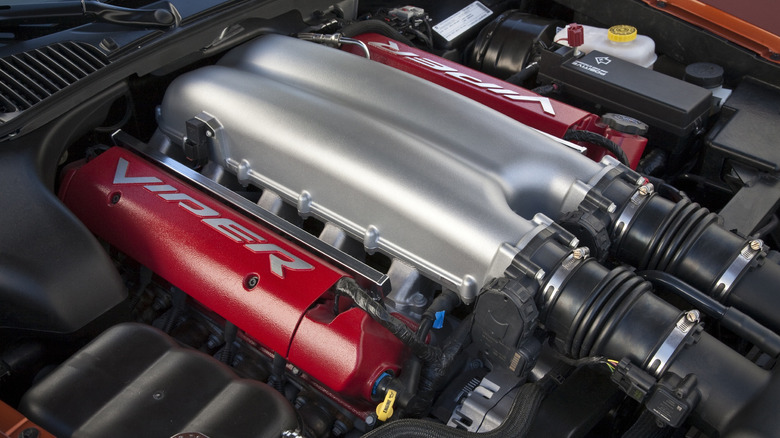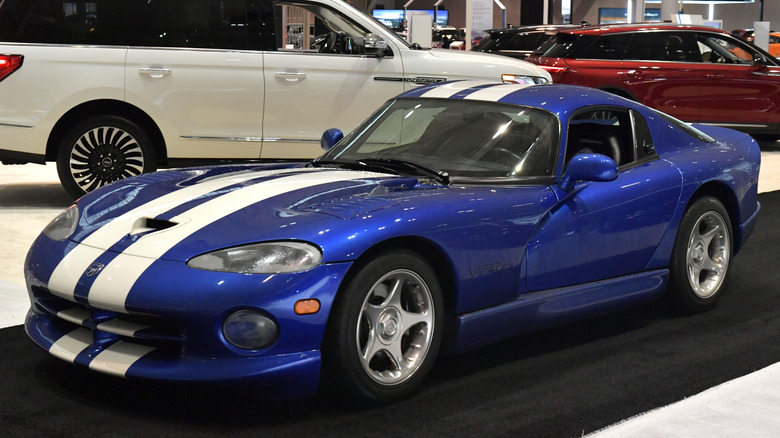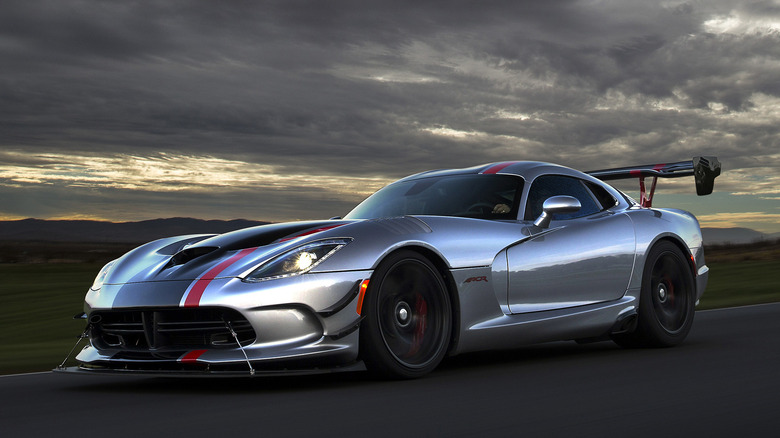Here's What Made The Dodge Viper V10 Engine So Special
In 1992, under the tutelage of chairman Lee Iacocca, Dodge stunned the automotive world by unleashing a visceral brute of roadster reminiscent of classics like the AC Cobra. What most folks will remember about the Viper is its massive V10 engine, long maligned as a derivative of the truck motor that Dodge offered in its Ram pickups. However, the Viper's V10 engine actually predated the introduction of the V10 engines in Ram trucks by two years.
According to former Viper Powertrain Engineer Dick Winkles, the Viper's V10 shares far more DNA with Chrysler's "LA" engines, with two extra cylinders added for good measure. The LA engines are a series of tough small block V8s (think 318, 340, 360 cubic inch) that powered everything from muscle cars, to pickup trucks, to police cars for four decades.
Perhaps the largest differentiation is that the truck V10 used a conventional iron engine block, while the Viper utilized a bespoke aluminum block — with engineering help from Lamborghini, having been owned by Chrysler between 1987 and 1994.
Aluminum is not as strong as iron, so considerable reinforcement was added to make the engine block pretty much bulletproof. However, it was heavy — approximately 700 pounds — somewhat negating the cornering and acceleration benefits of using an aluminum block to begin with.
The Viper goes on a diet
The first-gen Viper cranked out 400 horsepower and 450 pound-feet of torque from its 8.0 liter V10 — enough to propel the car from 0-60 MPH in 4.4 seconds, and a 13.1 second standing quarter-mile. As thrilling as the early Viper was to drive, it made no pretensions about being anything other than a barebones sports car. It had no air conditioning, no air bags, no outside door handles, and plastic curtains for side windows.
By the time the second-generation Viper V10 launched in 1996, engineers had put the engine on a serious diet by trimming unnecessary material from the block and cylinder heads. Dodge also fitted a more aggressive camshaft and a new, less restrictive exhaust system.
The first-generation used an exhaust system which exited out the side of the vehicle, ahead of the rear wheels, serving as a modern take on the "side pipes" that graced vintage cars like the Shelby Cobra and older Corvettes. This side exhaust had to be very quiet due to the close proximity to the occupants' eardrums.
Engineers reckoned that if they relocated the exhaust exits to the rear of the car, a louder free-flowing exhaust would be permissible. So the Viper gained 50 horsepower, the V10 now belting out over 450 horsepower, but lost its distinctive side exhaust. Fortunately, the side pipes would make a triumphant return in the 2003 third-generation car, with the addition of a crossover pipe to keep the volume in check.
The end of an era
When the Viper was eventually discontinued in 2017, its V10 had grown in size from 8.0 to 8.4 liters. That, coupled with modern technology such as CNC-ported cylinder heads, variable valve timing, and architecture borrowed from the HEMI, resulted in 645 horsepower and a stump-pulling 600 pound-feet of torque for the Viper's swan song. The Viper's 0-60 MPH could now be covered in a scant 3.5 seconds.
Dodge's insane roadster will always be remembered for Chrysler engineers' bold move to stuff a ten-cylinder motor under its long sculpted hood. This modern muscle car relied on good ole' displacement to make horsepower, rather than forced induction like superchargers or turbochargers that are commonplace in today's performance cars.
The Viper can also be credited with playing a huge role in pulling Chrysler out of the doldrums and back into the muscle car fold, paving the way for exciting models like the Charger and Challenger. Just don't say that it has a truck motor.


